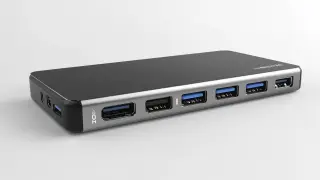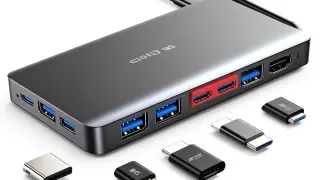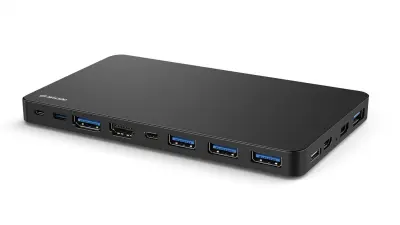
-
Home
-
Products
-
About Us
-
OEM&ODM
-
News
-
Blog
-
Contact Us
Inquiry
Form loading...

Beyond the instant spurts of flashy life and connectivity solutions lie work from remote and collaboration over digital. As reported by Statista, the global docking station market will reach $2.1 billion by 2025, with USB-C docking stations being prime movers in this wave of expansion. By offering multiple ports for laptops, tablets, and smartphones alike, Docking Station USB C solutions meet the needs of buyers from across the globe who look for greater versatility and utility in their workspaces.
Innovation is paramount among us at Zhongshan Sinseader Electronic Co., Ltd., founded in 2007. Our company has been involved in research, development, and manufacturing of superior USB hubs, docking stations, and related accessories over the years, signifying our stake in the supply of reliable products that enhance seamless connectivity. By putting into use the latest Docking Station USB C technology, we hope to empower users around the world with solutions that enhance productivity and elevate the digital experience altogether.

Tools that offer increased efficiency are also evolving with the changing dynamics of modern-day workspaces. USB-C docking stations fit into this category and are becoming indispensable as they enhance productivity and connectivity alike. The MarketsandMarkets report forecasts the global docking station market will reach $4.4 billion by 2026, growing at a CAGR of 6.2%. This growth is a telling indication of the devices' relevance within hybrid working environments today. USB-C docking stations are more attractive because of their ability to connect multiple ports into a single connection. USB-C docks connect power, data, and displays at the same time, reducing cable management and making workspaces more organized. The Daylighting Study by IDC states that 60% of professionals ranked cable management as an issue within their workspaces, so having a desirable docking solution will ultimately contribute to a focused, productive environment. Second, USB-C technology brings with it support for high-resolution displays and rapid data transfer. With USB 4.0, data is transferred at a whopping 40 Gbps speed, allowing professionals to transfer heavy files in seconds, which is a true boon in any fast-paced corporate setting. Third, the NPD Group report quoted that 75% of employees think that better visual experiences offered by USB-C docking stations fuel creative output and collaboration. Hence, USB-C docking stations are a modern-day solution for getting work done in any workspace, achieving connectivity needs, and creating an atmosphere of efficient collaboration. As more and more organizations understand the benefits of integration, it's easy to conclude that USB-C solutions are changing the way we work and are thus a great asset for global buyers targeting top productivity.

When thinking about a new USB-C docking station, some features can greatly influence productivity and entertainment experiences. The latest USB-C docking stations have many ports for users to connect several devices or peripherals. With the rapid development of USB-C, the latest technologies bring faster data transfer and a wider range of connectivity to the table.
Speed is one consideration favoring your next USB docking station. USB 3.1 Gen 2 models can offer double the transfer rate of their predecessors with regard to file transfer and loading times for applications. Multiple ports, such as HDMI and USB-A, enable the connection of a variety of devices at the same time without the hassle of changing cables repeatedly.
The design and portability of the docking station are also important. Many users favor lightweight and compact designs that fit comfortably in a laptop bag, making them user-friendly for professionals on the go. In addition, make sure the docking station you finally settle on is compatible with a variety of devices: smartphones and laptops running different operating systems. Such versatility guarantees that you are protecting your investment and making it future-proof for any tech ecosystem you may come across.

With USB-C technology coming of age, the operations of businesses around the world stand to become straighter and slipstreamed into efficiency. An IDC report says that shipments of over 1.4 billion USB-C devices will be seen per annum by 2024 - another operating indication of mass acceptance of this cross-sector standard. Such widespread integration gives rise to faster transfer speeds of around 40 Gbps with Thunderbolt 3 compatibility and power delivery of up to 100 watts to cater to the diverse needs of modern workplaces.
With USB-C being introduced, it holds the potential for businesses to streamline connectivity in digital-oriented environments. The Statista survey suggests that 60% of organizations have migrated to USB-C solutions in an effort to simplify their device ecosystems. Not only does this boost productivity for employees through avoiding downtime caused by incompatible devices, but it also fosters collaborative productivity by allowing ease of connecting peripherals such as monitors and docking stations to laptops and tablets.
Further, let us not forget the environmental impact which USB-C has. Standardizing the interface for charging and data transfer can help businesses curb electronic waste. In five years, this switch to USB-C could cut down e-waste by about 20 percent, according to estimates from the Global Data Consortium. With more companies caring about the environment, embracing USB-C technology is an important milestone toward achieving smoother operations while embracing eco-friendly practices.

In recent times, optimizing workflow has become an important factor for productivity in the current fast-paced world of work, and one of the most important accessories in this context is the latest USB-C docking stations. These devices not only offer easy and direct connectivity, but also allow a single hub from which multiple peripheral devices can be controlled. Use these devices easily for streamlining your activity. They give provisions to connect multiple monitors, keyboards, and other important devices. Because of this, the organization is not so much plagued with wires or numerous disconnections but has more well-organized working spaces.
Recent technological advancements have further sharpened the competency of modern docking stations in making them a one-stop shop for the global buyers. Fast charging is just one such example; devices are powered throughout the day with efficient fast data transfer for improved file sharing and collaboration possibilities. Just like MNG Kargo has been maximizing its workflow through innovative means such as possible because of the capability of cloud technology on automated package delivery, many other organizations across several industries have discovered that the right hardware and intelligent automation can lead to maximized productivity.
Docking stations are not just about benefits and convenience; they are also essential in promoting remote work or collaboration. The more an organization transitions from being entirely housed in a traditional office to a hybrid one, the more it needs seamless connectivity and propositions for effortless workflows. Investments in these state-of-the-art docking station setups will set organizations up to allow their teams to perform more effectively and efficiently, with the ultimate aim of leading to growth and remaining competitive in the marketplace.
The creation of the USB-C docking stations has availed infinite possibilities regarding connectivity, thus making them a necessity for any modern-day workflow. According to a report cited by Gartner, the USB-C docking station market worldwide will grow at a compounded annual growth rate (CAGR) of 18% from 2023 to 2028. Thus, with the spreading popularity of all devices conforming to this standard, this technology is helping users set up their workspace comfortably with a single universal connection.
(Considered comparison) USB-C docking stations are many steps ahead in comparison to conventional counterparts as far as whatever yardstick you may want to use. With common docking stations, functionality sometimes comes limited to a specific family of devices, also requiring many cables, ultimately crowding the workspace and making it inefficient. According to an IDC study, enterprises that use USB-C docks enjoy a 25% boost in productivity, as users easily plug and unplug their devices without the hassle of switching between multiple connectors. USB's versatility supports data transfer speeds hitting 10Gbps and Power Delivery, which is a lot fancier than the old USB standards.
Demand for flexible solutions that adapt to the workspace is thus on the rise with remote and hybrid work. USB-C docking stations firmly connect and support various peripherals, such as monitors, keyboard s, storage drives, etc., yet maintain a clean workspace. Therefore, according to Statista, 60% of remote workers prefer setups that optimize the workspace. This situation presents a transparent trend whereby ease and productivity take precedence. This transportation will advance USB-C solutions as appealing against traditional docking options in a world of rapidly updating technologies.
Seamless connectivity is paramount for personal or professional productivity in today's fast-paced digital landscape. USB-C docking stations are important tools in the maximization of this connectivity, providing versatile utility with numerous options to satisfy different user needs. Docking stations allow for the connection of several devices to a single port, which improves workflow efficiency and allows users to control their peripherals easily.
When it comes to ports and peripherals, USB-C docking stations lead the pack. They typically sport many connections, such as HDMI and DisplayPort, USB-A and Ethernet ports, so that users can easily connect displays, keyboards, mice, and external drives. This all-in-one functionality avoids the clutter of cords and peripherals while also making it easy for users who jump between devices and work in various environments to set everything up. A lot of docking stations even offer power delivery, so the ability to charge your laptop while using the dock becomes devoid of worries.
With remote work becoming more popular and flexible office configurations reaching the fore, global buyers are showing keen interest in USB-C docking stations that allow for great connectivity and versatility. Models enhanced with extra features such as SD card readers and audio jacks cater to creative professionals in need of strong data transfer capabilities as well as multimedia connectivity. These docking stations will, therefore, increasingly enhance the user experience for various applications as the market grows, proving that efficient connectivity is a must-have in today's workspace.
The rapid evolution of the USB-C docking solution roadmap can be attributed to high-stakes trends and regulatory changes within the industry. As evident from the EU announcement of standardizing USB-C as the universal charging standard by 2024 to all electronic devices, the shift to USB-C is becoming increasingly visible with technological progress. This landmark push will facilitate more excellent interoperability while cutting down on electronic waste as consumers would no longer require more than one charger for all devices.
Recently, top brands are shifting to USB-C interfaces; several products convert from proprietary connections to standard ones. You may observe that USB-C technology has now found its way into USB-C keyboards and mice as they become peripherals integrated into the technology — showing a wider acceptance in consumer electronics. According to the report released by the USB Implementers Forum, the global adoption of USB-C open-ended interfaces on laptops beside smartphones will cross the 70% mark by the end of 2025, creating a clear direction toward standardization.
Moreover, the versatility of USB-C cannot be overemphasized. It can now power, transfer data, and even display video output; all these functionalities make it the perfect one-stop solution to the new age docking stations. Transformative in terms of how we connect and engage with technology, it will push the productivity boundaries. As organizations increasingly adopt remote work solutions, so increases the demand for efficient docking solutions. This trend should reasonably progress with innovation in USB-C technologies, leaving an open door to a future with more streamlined and productive work environments.
The new business world is very dynamic; therefore, companies are always searching for novel alternatives to enhance productivity or streamline their operations. One major solution that is gaining traction today is using USB-C docking stations; they have become one of the critical areas in which companies are looking to maximize workspace. Real-world case studies also illustrate how various companies have adopted this new technology to great success.
For example, one prominent telecommunications provider was able to introduce advanced cloud solutions to hasten its innovation process. With USB-C docking solutions embedded into the scheme, interconnectivity among devices was enhanced for faster communication and teamwork. This integration has cut down on overhead costs, and the company now can respond rapidly to market demand.
Another wonderful case is in healthcare, where this market pioneer in dental implants widened its clientele onto foreign markets. The company has used USB-C docking stations to streamline its data management practices, thus enhancing real-time access to pertinent information during operations. This greatly improves the accuracy of their operations and thus helps in rendering superior service to their clients. Such examples showcase the great benefits that USB-C solutions can bring into any kind of business operation.
These studies show that adopting USB-C docking stations, far from being just a tech upgrade, is a strategic approach to changing workflow and productivity for the better. USB-C docking stations, as such, are, of course, the way to go as businesses learn to deal with a globalized market.
The global USB-C docking station market is expected to grow at a compound annual growth rate (CAGR) of 18% during that period.
Businesses using USB-C docks report a 25% increase in productivity, as users can easily connect and disconnect their devices without dealing with multiple connectors.
USB-C technology supports data transfer speeds of up to 10Gbps.
According to a survey, 60% of remote workers prefer setups that enhance workspace efficiency.
The European Union announced that all electronic devices must adopt USB-C as the universal charging standard by 2024.
The global adoption rate for USB-C interfaces in laptops and smartphones is projected to exceed 70% by the end of 2025.
USB-C functions as a power supply, supports data transfer, and allows for video output, making it an all-in-one solution for docking stations.
Many companies are transitioning from proprietary connectors to standardized USB-C interfaces for their products, such as keyboards and mice.
USB-C docking stations accommodate a variety of peripherals without the clutter of multiple cables, promoting a tidier workspace.
As remote work continues to grow, the demand for effective, adaptable USB-C docking solutions rises, helping to create more efficient work environments.




